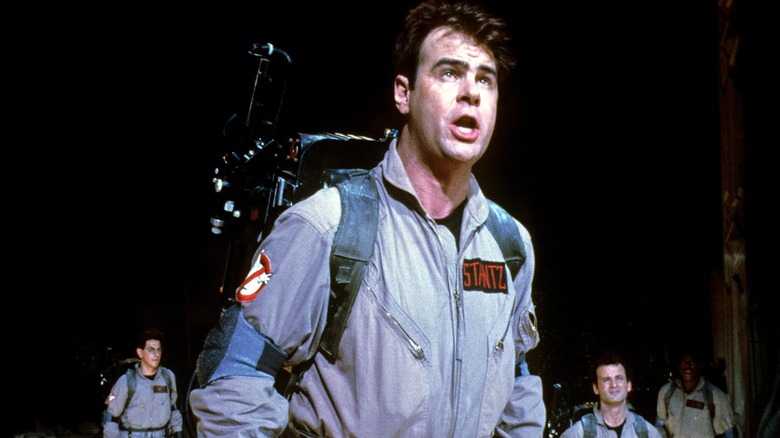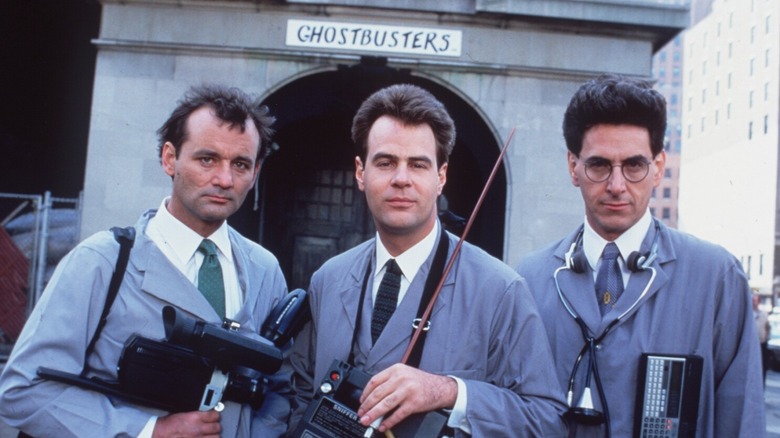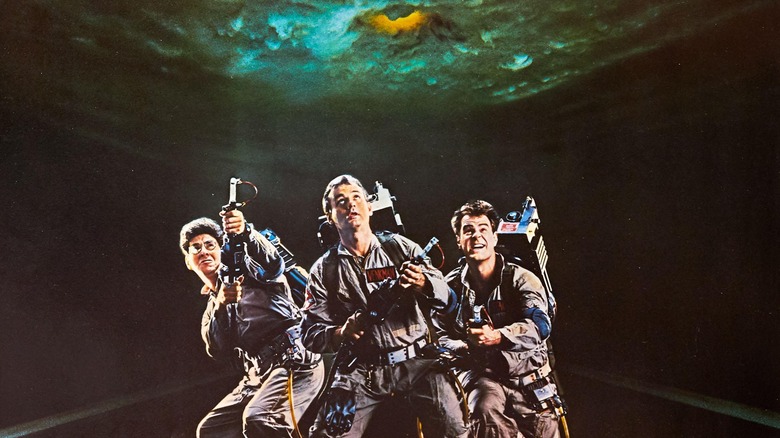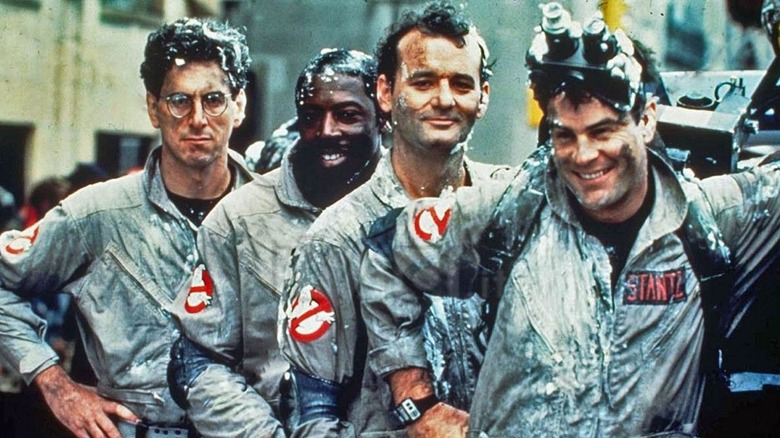How Dan Aykroyd's Supernatural Experience Shaped The Ghostbusters Script
A lot of what makes the original "Ghostbusters" an enduring classic is immediately apparent: a giant kaiju Marshmallow Man, the earworm that is Ray Parker Jr.'s theme song, and all things Bill Murray. Yet "Ghostbusters" would feel far less tangible and, dare we say, less authentic were it not for its presentation of the paranormal. After all, paraphernalia like the ghost trap, ectoplasm, and the phrase "class-5 full-roaming vapor" are too uncanny to be wholesale conjecture.
The reason the supernatural elements of "Ghostbusters" feel so anchored in reality (or at least some version of reality, depending on your own personal views) is thanks to co-writer and star Dan Aykroyd, whose own genuine belief in the paranormal has deep roots. Aykroyd's history with the spiritual and spectral not only gave birth to the very concept of "Ghostbusters," but provided the script and eventual film with such a unique and layered richness that couldn't help but make it compelling, not to mention hilarious.
The Aykroyd family and the great beyond
The paranormal isn't just a sole personal interest of Dan Aykroyd's — "it's the family business, for God's sake," as he put it in a 2014 Vanity Fair article. Aykroyd and his family consider themselves Spiritualists, and they indeed have a lengthy history with the supernatural. His great-grandfather regularly held séances on the family's farmhouse in Ontario, where the Aykroyds had their own medium on hand to help contact the beyond. Aykroyd's grandfather was a telephone engineer who was fascinated by the possibility of communicating with the dead by way of radio, and the "Saturday Night Live" alum's father authored the 2009 book "A History of Ghosts," which Dan Aykroyd wrote the introduction to.
While other Aykroyd projects, such as "Doctor Detroit" and "Nothing But Trouble," came more from his humorous daily experiences, his inspiration for "Ghostbusters" unsurprisingly sprung from an article in a parapsychology journal. Upon reading that article, Aykroyd thought "I'll devise a system to trap ghosts...and marry it to the old ghost [films] of the 1930s." The comedian observed that "virtually every comedy team did a ghost movie," doubtlessly thinking of such films as "Hold That Ghost" (starring Bud Abbott and Lou Costello), "The Ghost Breakers" (starring Bob Hope and Paulette Goddard), and "Ghost Chasers" (starring Leo Gorcey and the Bowery Boys).
Recognizing that his depth of knowledge about the paranormal could provide a ghost comedy with enough real parapsychology to make it unique, Aykroyd wrote the script for "Ghostbusters" with an eye toward giving the supernatural some tangibility.
A dose of a freaky ghost
The first draft of "Ghostbusters" by Aykroyd was far from what ended up on cinema screens in 1984. Entitled "Ghost Smashers," Aykroyd set the story in a future world of 2012, where a hole torn in the fabric of reality causes an influx of ghosts that in turn gives rise to the profession of ghostbusting. Aykroyd's Spiritualist history and knowledge is all over the massive 180-page tome, and director Ivan Reitman recalled that it concerned "many groups of Ghostbusters functioning in an intergalactic setting" that was, according to Aykroyd, "a lot darker" and "scarier" than the eventual movie.
Fortunately, Aykroyd was not precious about his work, acknowledging and even encouraging collaborative revisions that would allow the film to be made. Aykroyd knew that he was "a better originator than executor of a finished screenplay," admitting that he was "a kitchen-sink writer: I throw everything in there" and that he's "always relied on a collaborator to bring it into reality."
Thankfully, it was Reitman who suggested his "Animal House" and "Stripes" cohort Harold Ramis could help rewrite and shape the script, and he happily discovered that "Dan was great, and very open" to Ramis being brought on board. The two men then got to work on a new draft that played to both their strengths, with Aykroyd "creating funny situations," as Ramis put it, while he wrote "more in the area of strong jokes and funny dialogue." With the two comedy wunderkinds supporting each other, "Ghostbusters" was formed into a coherent and shootable script.
Bustin' makes me feel good
While Ramis, Reitman, and eventually Murray (via his superlative ad-libs) contributed a great deal to "Ghostbusters'" final script, the unique tone, terminology, and concept of Aykroyd's original Spiritualist-influenced vision remained. Aykroyd's beliefs give the movie both a blue-collar, everyday approach to the supernatural as well as an uncanny and bizarre conception of it. Granted, his talent as a comedian doubtlessly influenced the wide range of the ghost creatures seen in the final film, from the more classic Library Ghost to the menacing Terror Dogs to the cartoonish Onionhead/Slimer and the Stay Puft Marshmallow Man. Yet even the most outlandish of these characters have weight to them, thanks to scenes like the three Ghostbusters having to clean up the sticky, gooey ectoplasm or "slime" that ghosts leave behind.
Aykroyd has always had an affinity for Joe Friday-style matter-of-fact speeches, and it's no coincidence that his "Ghostbusters" character of Ray Stantz is the character who sells the reality of ghostbusting to the audience. His clipped Chicago-by-way-of-Ontario delivery makes such wildly fantastical ideas like trapping a ghost and then "storing" that ghost in a containment system seem not only plausible but practical. With his character of Ray and "Ghostbusters" as a whole, Aykroyd more than accomplished his original goals for the film, creating a comedy team ghost movie while making the supernatural seem real — because, at least for Aykroyd, it is.



